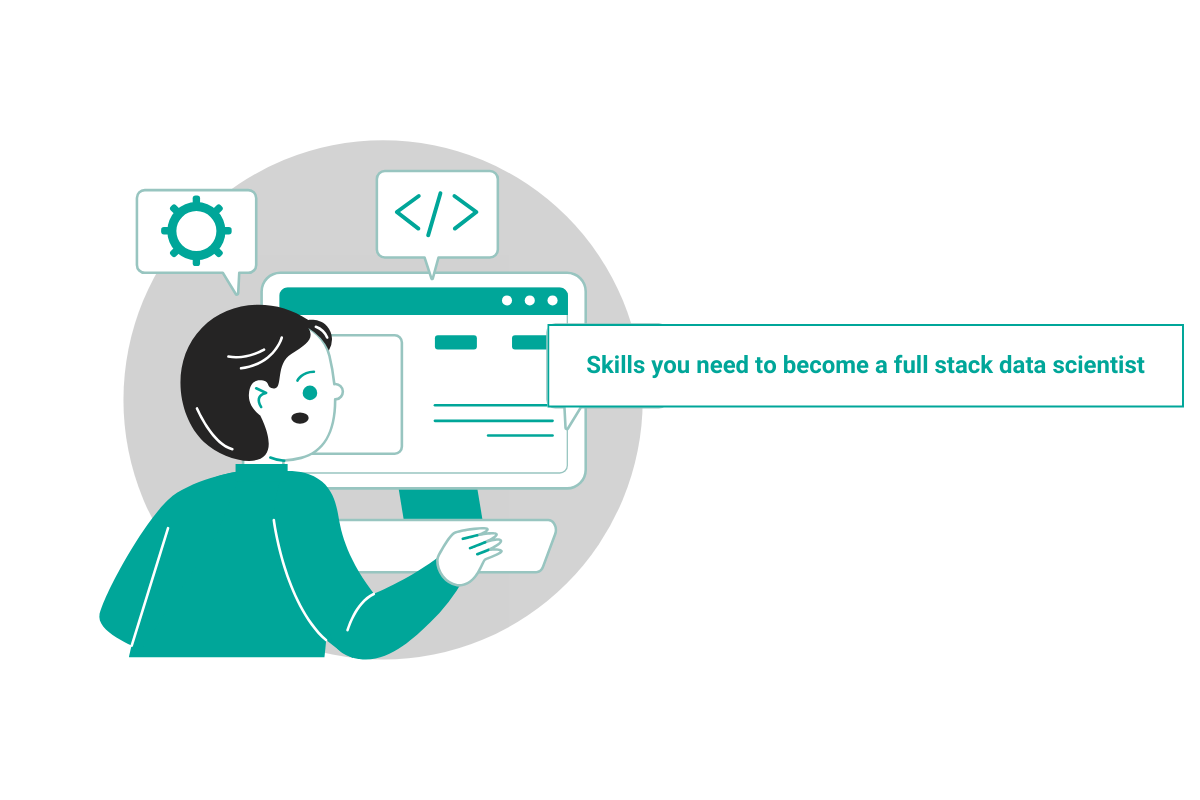How to Become a Full Stack Data Scientist

 Written by:
Written by:Zulie Rane
A full breakdown of the 7 key skills you need to become a full stack data scientist.
Working in the full stack, whether as a data scientist or as a software developer, is about knowing how to implement the project from start to finish. The term was originally used for software developers who can do both frontend and backend work. They can work the full stack, from the buttons on the UI down to the gritty backend architecture and algorithms.
A full stack data scientist is someone who can identify the problem, understand it in the context of the business, develop models to analyze the relevant data, and deploy these models to production.
Let’s dive deeper into what data science is, what a full stack data scientist does, and what you need to know to become one.
What is Data Science?
As the Internet becomes ever-present in our lives, more and more data is generated. In 2020, every human on the planet created 1.7 MB of data on average every second. This data generates business opportunities, like targeted Facebook ads or more accurate and persuasive recommendations for products on retailers’ websites.
Data science is the field that aims to make sense out of all these numbers that track who a consumer is, what they prefer, and what businesses should do about it. Data science is a combination of statistics, artificial intelligence, scientific methods, and data analysis to “extract value from data”, according to Oracle.
Data science is about collecting vast amounts of data and boiling it down to key values that help make sense of it, usually from a business perspective. It has so many fascinating applications, like improving the efficiency of a logistics company by analyzing traffic and weather patterns, or aiding doctors in making medical diagnoses.
What is a Data Scientist?
A data scientist is the person who takes these ridiculous amounts of data and uses it to answer those pressing questions. A data scientist is responsible for revealing the trends hidden in the data and for using these trends to output insights that can guide business decisions. Check out our guide to all the data science job titles or roles you can consider if you have a data science background.
To understand specifically what a full-stack data scientist is, let’s first take a look at what the full stack of data science is.
The Full Stack of Data Science
A full stack data scientist must be able to develop models, test and validate them, deploy them to production, refine the model, and test again.
The full stack of data science involves six key steps which form a cycle. First, you must plan. You need an idea or a problem you’re looking to solve. Are the conversion rates of a sign-up form low? Do people typically make an initial purchase from the store but then rarely return? Find a question that is worth answering in order to improve the success of the business. It’s crucial to understand the needs of the business and be able to explain why analyzing the problem using data science will produce better results for the business.
Second, you need to collect and clean the data. Cleaning data means “fixing or removing incorrect, corrupted, incorrectly formatted, duplicate, or incomplete data within a dataset,” according to Tableau. Figure out exactly which data sources you are going to use and prep the data.
Next, you’ll need to perform some exploratory data analysis. Exploratory data analysis is your opportunity to “deeply inspect all the data features, data properties, build confidence in the data, gain intuition about the data, conduct a sanity check, figure out how to handle each feature, etc.” This is your time to get a feel for the data and start thinking about which models you may want to use.
The following step is to actually build the model. You split the data you meticulously collected and cleaned into training and testing data sets. You’ll use the training set to build the predictive models and then evaluate their performance using the unseen test data set.
Once you’ve built and evaluated your model(s), it’s important you reflect on and share the results. What did your models show you? What answers have you found to the questions you started out with, and what business impact could there be? There are lots of ways to evaluate machine learning models, like using a confusion matrix, receiver operating characteristic (ROC) curve, or determining the accuracy, precision, and specificity of the model.
Finally, you’ll need to deploy and maintain your model. This may be the most important step, but also one of the more tedious ones. To make your work truly valuable, you need to make it available to others. By publishing the model to production, you’ll provide the most impact for your organization.
Don’t forget either that the only static thing in life is change. Your ML model will likely need to be updated over time, as consumer or traffic patterns can change, and you need to make sure your model is outputting the most accurate recommendations possible.
7 Key Skills for Full-Stack Data Science
The beauty and challenge of full-stack data science is that it is truly a wide stretch of required skills. You have to be able to understand the business problem, manipulate the data, develop models, build pipelines to publish the models, and understand the business impact of the results. In order to successfully perform as a full-stack data scientist, you’ll need a strong grasp of a variety of topics. You’ll need a theoretical understanding and will need to be comfortable putting your knowledge into practice for various applications. The list of required skills includes, but is not limited to: math, databases, machine learning, computer science fundamentals, pipelines, deployments, and business knowledge.
Math

When it comes to math, you need to be familiar with linear algebra, calculus, probability, statistics, and convex optimization. All of these disciplines are crucial to having a firm grasp on statistical analysis and machine learning, the two basic building blocks of data science.
Design Databases
When gathering, cleaning, and manipulating data, you’ll need to understand how to design databases as well as how to interact with them. In the modern age of big data, it’s all stored on databases in the cloud.
You’ll need to be proficient in writing queries using languages like SQL, in order to organize the data you will use. A lot of data analytics uses machine learning to develop the models used to make sense of the masses of data as well as make predictions based on existing data.
Machine Learning

Some of the most popular data science models come from machine learning, like decision trees, k-means clustering, and support-vector machines. This article walks through an application of a decision tree model on predicting a person’s loan eligibility based on data like their gender, marital status, credit score, education status, and whether they were self-employed. A data scientist is most powerful when you are able to make predictions about future behavior. If you can predict the twists and turns the stock market will take, or more simply be able to predict how much butter U.S consumers will purchase in the next month, your work will have significant business impact.
Machine learning models aim to predict outcomes. It uses algorithms to uncover patterns in data. By taking training data and building a model that is able to learn from the data and outcomes it is given, you can predict those outcomes for unseen data. Machine learning involves highly complex mathematical systems that can process and makes sense of data without you writing thousands of lines of intricate code. It’s a field full of powerful tools and libraries like numpy, Pytorch, TensorFlow, Pandas, and many more.
Computer Science Fundamentals
Subject areas like data structures, algorithms, version control, and discrete mathematics are crucial subjects for data science. Data science is ultimately a discipline of computer science, and the models you develop and publish will likely be housed within a larger application. It’s important that you understand the performance implications of sorting your data type using bubble sort versus merge sort. Additionally, how you choose to represent the data in the form of an object can affect the usability of the results. Will you return the raw results or aggregate them? What information is relevant to the user of your model?
Sharing your model after you’ve trained it is critical. A model that is never used is a poor use of your time and resources. A great way to publish your models in an effective way is to share them via an API. Best practices for programming will be crucial in order to succeed as a full-stack data scientist.
Creating and Maintaining Data Pipelines
Scheduling and executing regular deployments is very important in the role of a full-stack data scientist. Your beautiful model is of use to no one if you don’t have a pipeline for it to accept new data inputs to produce useful insights.
You have to create a pipeline so that users of your model can input data to receive the relevant predictions. Your models to predict the demand for an array of products next month won’t be very useful if everyone is relying on you to manually take their input data, run it through your model, and send back the predictions. Your model becomes significantly more useful if this process is automated with a pipeline. Valohai writes, “for data science teams, the production pipeline should be the central product. It encapsulates all the learned best practices of producing a machine learning model for the organization’s use-case and allows the team to execute at scale.” Executing at scale is the difference between being of use to your company and being burned resources.
Deployments
Once you’ve made your pipeline, you should be able to deploy new releases of your model. Deployments are important for you to push out improvements and tweaks you make to your model. Models cannot be left to sit alone. Don’t assume that its performance will be sustained. For example, if you built your model on consumer behavior, think about what could change that. The Covid-19 pandemic drastically changed the way and things consumers purchase. You cannot assume that your model’s accuracy will be sustained. Be prepared to iteratively improve it and have the deployment pipeline built in order to provide your pipeline’s users with these improvements.
Business Knowledge

Business knowledge is a key skill that sets a full-stack data scientist apart from a regular one. You need to have a big-picture understanding of why you are creating these models and what exactly they are being used for. Ask yourself where the data is coming from and why your organization is asking you to use it. You’ll need to be able to recommend which areas of your organization’s business applications should be tackled next and be able to create action items from the results of your analyses. A data scientist should “find innovative solutions and interpret results in the correct way to add value to the business,” according to Prasad Pore.
Companies have data scientists because they are interested in making impactful business decisions based on data. You’ll need to have a strong understanding of the effect your model’s predictions could have on the business as well as why that matters.
How to Become a Full Stack Data Scientist
On top of those topics listed above that you’ll need a very strong understanding of, you’ll need practical skills as well.
When it comes to explicit technical skills you should have, several come to mind. Most notably, you should be very comfortable programming in Python and R. R is great for statistical analysis as well as cleaning and organizing your data, and Python is the industry standard programming language for machine learning.
You should also be familiar with Python libraries like NumPy, Pytorch, TensorFlow, and Pandas. Employers often also require proficiency in a more classical programing language, like C, C# or Java. You should also brush up on relational databases and be comfortable developing complex queries.
A great strategy to gaining these skills as well as a way to showcase them is by working on personal data science projects. You could step through each part of the full stack data scientist development cycle to produce a fascinating and shiny model that can become a great section on your resume as well as a talking point in technical interviews.
Also, check out our comprehensive guide on 'How to Become a Data Scientist from Scratch' that will take you through every necessary step to become a successful data scientist.
Why You Should Become a Full Stack Data Scientist

Full stack data scientists get the opportunity to straddle a lot of different fields. You have the chance to gain an incredibly diverse skill set and apply it to interesting, challenging problems. If you’re a fan of open-ended questions, this is a great career for you. The industry is young, and demand for full-stack data scientists is incredibly high.
This career will allow you to have a significant business impact. You can bring a lot of value to a data science company, and your numerous skills will make you a coveted member of any team. By bridging the business side to data analytics, you get to touch each part of the process yourself, meaning you’ll have a lot of autonomy.
Besides the qualitative benefits of becoming a full-stack data scientist, there are also very strong financial incentives. The average base salary for a full-stack data scientist is $118K in the United States, and it can range up to $168,000. Check out our article 'Data Scientist Salary' to find out about salaries in Data Science and how they are influenced by various factors.
As the world continues to digitize and more and more data is generated, which can then be put to use, the demand for full-stack data scientists will only grow.
If money alone isn’t enough to convince you, don’t forget to consider the autonomy and power that come with a full stack data science position. Because you are responsible for the full development cycle, you get a lot of say in how things are developed, what problems get tackled next, and deciding how to maintain and iteratively improve existing models. The crazy growth in the industry also indicates very attractive job security.
There are a lot of reasons why you should become a full stack data scientist. Though you’ll need a lot of knowledge and skills for the role, it’s sure to be one that remains challenging and interesting.
Share


